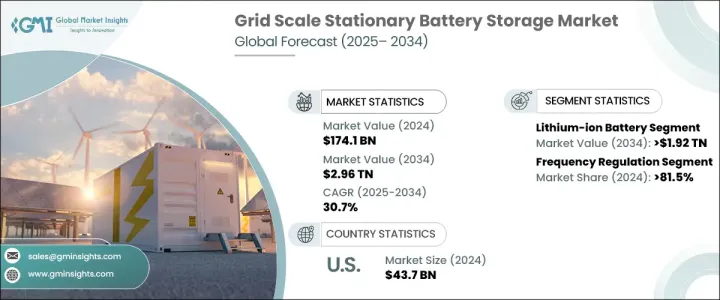PUBLISHER: Global Market Insights Inc. | PRODUCT CODE: 1716720

PUBLISHER: Global Market Insights Inc. | PRODUCT CODE: 1716720
Grid Scale Stationary Battery Storage Market Opportunity, Growth Drivers, Industry Trend Analysis, and Forecast 2025 - 2034
The Global Grid Scale Stationary Battery Storage Market was valued at USD 174.1 billion in 2024 and is projected to grow at a CAGR of 30.7% between 2025 and 2034. This exponential growth is driven by the increasing integration of renewable energy sources like solar and wind, which require reliable and efficient storage solutions to maintain grid stability and meet fluctuating energy demands. As the world shifts toward cleaner energy alternatives, grid-scale battery storage plays a pivotal role in ensuring a stable and consistent power supply. Renewable energy generation is inherently intermittent, making energy storage systems essential to store excess energy during peak production and release it during periods of high demand. Governments and regulatory authorities across the globe are also implementing policies and providing incentives to encourage the deployment of grid-scale battery storage systems.

Additionally, the declining costs of advanced battery technologies, coupled with innovations in energy storage solutions, are making large-scale adoption feasible across diverse markets. The growing emphasis on decarbonization and achieving net-zero targets further strengthens the demand for scalable and efficient energy storage solutions. Energy-intensive industries and utilities are increasingly adopting battery storage to reduce dependency on fossil fuels and optimize grid operations, contributing to the market's impressive growth trajectory. The proliferation of smart grid technologies and demand-side management strategies is also accelerating the deployment of grid-scale battery storage systems, offering a robust framework for future growth.
| Market Scope | |
|---|---|
| Start Year | 2024 |
| Forecast Year | 2025-2034 |
| Start Value | $174.1 Billion |
| Forecast Value | $2.96 Trillion |
| CAGR | 30.7% |
The market is segmented by battery type into sodium-sulfur, lithium-ion, flow batteries, lead-acid, and others. Lithium-ion batteries lead this space and are expected to generate USD 1.92 trillion by 2034. These batteries, known for their fast charging and discharging capabilities, are ideal for applications such as frequency regulation, grid stabilization, and balancing renewable energy sources. Advances in battery chemistry, improved thermal management systems, and enhanced energy density have significantly increased the lifespan, safety, and efficiency of lithium-ion batteries. Their ability to provide rapid response times and higher energy density makes them a preferred choice for large-scale grid storage projects. As the cost of lithium-ion batteries continues to decline, their adoption in grid-scale applications is expected to rise exponentially.
In terms of application, the grid scale stationary battery storage market includes frequency regulation, black start services, energy shifting, capacity deferral, capacity firming, and other services. The frequency regulation segment held an impressive 81.5% market share in 2024. Several regions are implementing market incentives and frameworks to encourage the use of battery storage systems for frequency regulation. In the U.S., energy storage systems are incentivized to provide essential grid services, ensuring stability and efficiency in energy distribution. These incentives, coupled with increasing investments in grid modernization initiatives, are fueling the rapid expansion of the battery storage market.
The U.S. grid scale stationary battery storage market was valued at USD 43.7 billion in 2024, with favorable federal policies such as the Investment Tax Credit (ITC) and Production Tax Credit (PTC) stimulating substantial investments in energy storage infrastructure. These incentives have made battery storage systems more financially viable, especially in states like California, Texas, and Hawaii, where grid modernization efforts and renewable energy integration are priorities. State-level mandates further enhance the adoption of grid-scale battery storage, supporting grid reliability, renewable energy adoption, and frequency regulation across the U.S.
Table of Contents
Chapter 1 Methodology & Scope
- 1.1 Market definitions
- 1.2 Base estimates & calculations
- 1.3 Forecast calculation
- 1.4 Data sources
- 1.4.1 Primary
- 1.4.2 Secondary
- 1.4.2.1 Paid
- 1.4.2.2 Public
Chapter 2 Executive Summary
- 2.1 Industry synopsis, 2021 - 2034
Chapter 3 Industry Insights
- 3.1 Industry ecosystem analysis
- 3.2 Regulatory landscape
- 3.3 Industry impact forces
- 3.3.1 Growth drivers
- 3.3.2 Industry pitfalls & challenges
- 3.4 Growth potential analysis
- 3.5 Porter's analysis
- 3.5.1 Bargaining power of suppliers
- 3.5.2 Bargaining power of buyers
- 3.5.3 Threat of new entrants
- 3.5.4 Threat of substitutes
- 3.6 PESTEL Analysis
Chapter 4 Competitive Landscape, 2024
- 4.1 Introduction
- 4.2 Strategic outlook
- 4.3 Innovation & sustainability landscape
Chapter 5 Market Size and Forecast, By Battery, 2021 - 2034, (MW & USD Million)
- 5.1 Key trends
- 5.2 Lithium-ion
- 5.3 Sodium sulphur
- 5.4 Lead acid
- 5.5 Flow battery
- 5.6 Others
Chapter 6 Market Size and Forecast, By Application, 2021 - 2034, (MW & USD Million)
- 6.1 Key trends
- 6.2 Frequency regulation
- 6.3 Black start services
- 6.4 Energy shifting & capacity deferral
- 6.5 Capacity firming
- 6.6 Others
Chapter 7 Market Size and Forecast, By Region, 2021 - 2034, (MW & USD Million)
- 7.1 Key trends
- 7.2 North America
- 7.2.1 U.S.
- 7.2.2 Canada
- 7.2.3 Mexico
- 7.3 Europe
- 7.3.1 UK
- 7.3.2 France
- 7.3.3 Germany
- 7.3.4 Italy
- 7.3.5 Russia
- 7.3.6 Spain
- 7.4 Asia Pacific
- 7.4.1 China
- 7.4.2 Australia
- 7.4.3 India
- 7.4.4 Japan
- 7.4.5 South Korea
- 7.5 Middle East & Africa
- 7.5.1 Saudi Arabia
- 7.5.2 UAE
- 7.5.3 South Africa
- 7.6 Latin America
- 7.6.1 Brazil
- 7.6.2 Argentina
Chapter 8 Company Profiles
- 8.1 BYD Company
- 8.2 Contemporary Amperex Technology
- 8.3 Exide Technologies
- 8.4 GS Yuasa International
- 8.5 Hitachi Energy
- 8.6 HOPPECKE Batterien
- 8.7 Johnson Controls
- 8.8 LG Energy Solution
- 8.9 Panasonic Corporation
- 8.10 SAMSUNG SDI
- 8.11 Siemens Energy
- 8.12 SK Innovation
- 8.13 Tesla
- 8.14 Toshiba Corporation




